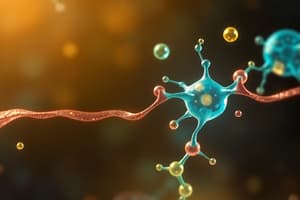Podcast
Questions and Answers
Which of the following drugs is the first-line treatment for anaphylactic shock?
Which of the following drugs is the first-line treatment for anaphylactic shock?
- Norepinephrine
- Midodrine
- Dopamine
- Epinephrine (correct)
What is the primary action of epinephrine as a local vasoconstrictor?
What is the primary action of epinephrine as a local vasoconstrictor?
- Increases blood flow to the site
- Prolongs the action of opioids
- Prolongs the action of local anesthetics (correct)
- Enhances bleeding during surgery
What type of shock is norepinephrine primarily used to treat?
What type of shock is norepinephrine primarily used to treat?
- Cardiogenic shock
- Neurogenic shock
- Septic shock (correct)
- Anaphylactic shock
Which of the following agents is classified as an alpha-1 selective agonist and is used as a decongestant?
Which of the following agents is classified as an alpha-1 selective agonist and is used as a decongestant?
What distinguishes direct agonists from indirect agonists in the context of sympathomimetics?
What distinguishes direct agonists from indirect agonists in the context of sympathomimetics?
What is the end product of Tyrosine metabolism?
What is the end product of Tyrosine metabolism?
Which substance inhibits the reuptake of neurotransmitters?
Which substance inhibits the reuptake of neurotransmitters?
What is the primary mechanism for the termination of norepinephrine's effects?
What is the primary mechanism for the termination of norepinephrine's effects?
Which drug is known to inhibit vesicular uptake of catecholamines?
Which drug is known to inhibit vesicular uptake of catecholamines?
Which of the following is required for the release of norepinephrine from vesicles?
Which of the following is required for the release of norepinephrine from vesicles?
Flashcards are hidden until you start studying
Study Notes
Uptake of Tyrosine
- Tyrosine is considered the most significant amino acid.
- End product of tyrosine metabolism is Vanillyl Mandelic Acid (VMA), with normal urinary levels ranging from 4 mg to 8 mg per day.
- Increased levels of VMA may indicate a tumor in the adrenal medulla, known as Pheochromocytoma.
- Tyrosine conversion to dopamine includes a rate-limiting step; this slowest and most important step is critical for catecholamine synthesis.
- Dopamine is formed from L-Dopa, leading to the first catecholamine.
Catecholamine Storage and Release
- Dopamine is transported and stored by the Vesicular Monoamine Transporter (VMAT).
- Reserpine, an alkaloid, inhibits this vesicular storage process.
- The conversion of dopamine to norepinephrine occurs in the adrenal medulla.
- Norepinephrine release involves exocytosis and requires calcium ions (Ca²⁺).
- Bretylium, Guanethidine, and Guanadrel are inhibitors of NE release.
Adrenergic Drugs and Their Effects
- Adrenergic agonists, also known as sympathomimetic drugs, activate adrenoceptors.
- Epinephrine is a non-selective adrenergic agonist used in cardiac arrest resuscitation and anaphylactic shock (via EpiPen).
- Norepinephrine is the drug of choice (DOC) for septic shock.
- Dopamine is preferred for shock associated with renal involvement.
Direct-Acting Sympathomimetics
- Direct agonists activate adrenoceptors directly; indirect agonists enhance the actions of endogenous catecholamines.
- Alpha-1 selective agonists are used as nasal and eye decongestants, e.g., Midodrine (for chronic orthostatic hypotension) and Phenylephrine (mydriatic agent).
- Bromocriptine acts as a D2-agonist for Parkinson's disease and prolactinemia.
Indirect-Acting Sympathomimetics
- Amphetamine-like releasers increase norepinephrine and blood pressure and are used as stimulants.
- Isoproterenol is a non-selective beta agonist and administered for atrioventricular blocks, providing bronchodilator effects.
Antinicotinic and Neuromuscular Blockers
- Antinicotinic effects include dry mouth, mydriasis, tachycardia, and elevated body temperature.
- Succinylcholine is a depolarizing neuromuscular blocker with a short duration, used for rapid intubation.
- Non-depolarizing blockers cause paralysis without initial contraction.
Cholinesterase Inhibitors
- Neostigmine is the drug of choice for atropine poisoning and used to treat myasthenia gravis.
- Pyridostigmine is preferred for chronic myasthenia gravis due to its selectivity and longer duration.
- Trimethaphan is rarely used, primarily in emergencies.
Contraindications
- Non-selective drugs are contraindicated in acute angle closure glaucoma and prostatic hyperplasia.
- Special caution is advised for patients with acid-peptic disease, as these drugs may slow gastric emptying and exacerbate symptoms.
Studying That Suits You
Use AI to generate personalized quizzes and flashcards to suit your learning preferences.




